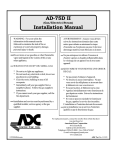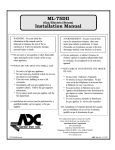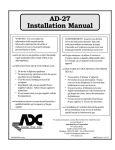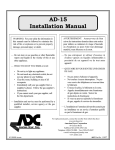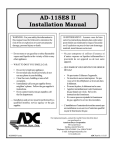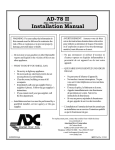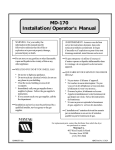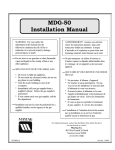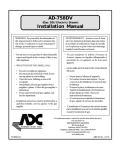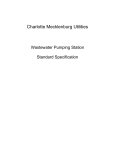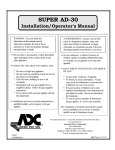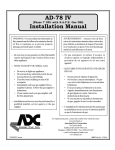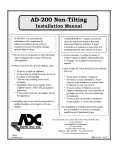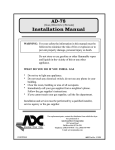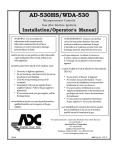Download Maytag MDG-75 Installation manual
Transcript
MDG-75 (Direct Spark Ignition) Installation Manual WARNING: For your safety the information in this manual must be followed to minimize the risk of fire or explosion or to prevent property damage, personal injury or death. AVERTISSEMENT: Assurez-vous de bien suivre les instructions données dans cette notice pour réduire au minimum le risque d’incendie ou d’explosion ou pour éviter tout dommage matériel, toute blessure ou la mort. Do not store or use gasoline or other flammable vapor and liquids in the vicinity of this or any other appliance. Ne pas entreposer ni utiliser d’essence ni d’autres vapeurs ou liquides inflammables dans le voisinage de cet appareil ou de tout autre appareil. WHAT DO YOU DO IF YOU SMELL GAS * Do not try to light any appliance. * Do not touch any electrical switch; do not use any phone in your building. * Clear the room, building or area of all occupants. * Immediately call your gas supplier from a neighbor's phone. Follow the gas supplier's instructions. * If you cannot reach your gas supplier, call the fire department. Installation and service must be performed by a qualified installer, service agency or the gas supplier. QUE FAIRE SI VOUS SENTEZ UNE ODEUR DE GAZ: * Ne pas tenter d’allumer d’appareil. * Ne touchez à aucun interrupteur. Ne pas vous servir des téléphones se trouvant dans le bâtiment où vous vous trouvez. * Évacuez la pièce, le bâtiment ou la zone. * Appelez immédiatement votre fournisseur de gaz depuis un voisin. Suivez les instructions du fournisseur. * Si vous ne pouvez rejoindre le fournisseur de gaz, appelez le service des incendies. L’installation et l’entretien doivent être assurés par un installateur ou un service d’entretien qualifié ou par le fournisseur de gaz. For replacement parts, contact the distributor from which the dryer was purchased or MAYTAG 403 West Fourth Street North Newton, Iowa 50208 (515) 792-7000 122299MS/tcosta Part No. 113123 Retain This Manual In A Safe Place For Future Reference Our products embody advanced concepts in engineering, design, and safety. If this product is properly maintained, it will provide many years of safe, efficient, and trouble-free operation. ONLY qualified technicians should service this equipment. OBSERVE ALL SAFETY PRECAUTIONS displayed on the equipment or specified in the installation manual included with the dryer. The following “FOR YOUR SAFETY” caution must be posted near the dryer in a prominent location. FOR YOUR SAFETY POUR VOTRE SÉCURITÉ Do not store or use gasoline or other flammable vapors or liquids in the vicinity of this or any other appliance. Ne pas entreposer ni utiliser d’essence ni d’autres vapeurs ou liquides inflammables dans le voisinage de cet appareil ou de yout autre appareil. We have tried to make this manual as complete as possible and hope you will find it useful. Manufacturer reserves the right to make changes from time to time, without notice or obligation, in prices, specifications, colors, and material, and to change or discontinue models. The illustrations included in this manual may not depict your particular dryer exactly. Important For your convenience, log the following information: DATE OF PURCHASE MODEL NO. MDG-75 DISTRIBUTORS NAME Serial Number(s) For replacement parts, contact the distributor from which the dryer was purchased or contact: MAYTAG 403 West Fourth Street North Newton, Iowa 50208 (515) 792-7000 “IMPORTANT NOTE TO PURCHASER” Information must be obtained from your local gas supplier on the instructions to be followed if the user smells gas. These instructions must be posted in a prominent location near the dryer. IMPORTANT YOU MUST DISCONNECT and LOCKOUT THE ELECTRIC SUPPLY and THE GAS SUPPLY BEFORE ANY COVERS or GUARDS ARE REMOVED FROM THE MACHINE TO ALLOW ACCESS FOR CLEANING, ADJUSTING, INSTALLATION, or TESTING OF ANY EQUIPMENT per OSHA (Occupational Safety and Health Administration) STANDARDS. “Caution: Label all wires prior to disconnection when servicing controls. Wiring errors can cause improper operation.” «Attention: Lor des opérations d’entretien des commandes étiqueter tous fils avant de les déconnecter. Toute erreur de câblage peut étre une source de danger et de panne.» CAUTION DRYER(S) SHOULD NEVER BE LEFT UNATTENDED WHILE IN OPERATION. WARNING CHILDREN SHOULD NOT BE ALLOWED TO PLAY ON OR NEAR THE DRYER(S). CHILDREN SHOULD BE SUPERVISED IF NEAR DRYER(S) IN OPERATION. FOR YOUR SAFETY DO NOT DRY MOP HEADS IN THE DRYER. DO NOT USE DRYER IN THE PRESENCE OF DRY CLEANING FUMES. WARNING UNDER NO CIRCUMSTANCES should the dryer door switch or the heat safety circuit devices ever be disabled. WARNING The dryer must never be operated with any of the back guards, outer tops, or service panels removed. PERSONAL INJURY OR FIRE COULD RESULT. WARNING DRYER MUST NEVER BE OPERATED WITHOUT THE LINT FILTER/SCREEN IN PLACE, EVEN IF AN EXTERNAL LINT COLLECTION SYSTEM IS USED. IMPORTANT PLEASE OBSERVE ALL SAFETY PRECAUTIONS displayed on the equipment and/or specified in the installation manual included with the dryer. Dryers must not be installed or stored in an area where it will be exposed to water or weather. The wiring diagram for the dryer is located in the front electrical control box area. Table of Contents SECTION I IMPORTANT INFORMATION .......................................................................... 3 A. Receiving and Handling ............................................................................................................... 3 B. Safety Precautions ...................................................................................................................... 4 SECTION II SPECIFICATIONS/COMPONENT IDENTIFICATION .................................. 6 A. Specifications ............................................................................................................................. 6 B. Component Identification ............................................................................................................ 8 SECTION III INSTALLATION PROCEDURES .................................................................... 10 A. B. C. D. E. F. G. H. I. J. K. Location Requirements ............................................................................................................. 10 Unpacking/Setting Up ................................................................................................................11 Dryer Enclosure Requirements .................................................................................................. 12 Fresh Air Supply Requirements ................................................................................................. 13 Exhaust Requirements ............................................................................................................... 14 Electrical Information ................................................................................................................ 19 Gas Information........................................................................................................................ 25 Preparation For Operation/Start-up .......................................................................................... 29 Preoperational Tests ................................................................................................................. 30 Preoperational Instructions ........................................................................................................ 32 Shut Down Instructions ............................................................................................................. 33 SECTION IV SERVICE/PARTS INFORMATION ................................................................. 34 A. Service ..................................................................................................................................... 34 B. Parts ........................................................................................................................................ 34 SECTION V WARRANTY INFORMATION ......................................................................... 35 A. Returning Warranty Cards......................................................................................................... 35 SECTION VI ROUTINE MAINTENANCE ............................................................................ 36 A. Cleaning ................................................................................................................................... 36 B. Adjustments ............................................................................................................................. 37 C. Lubrication ............................................................................................................................... 37 SECTION VII PROCEDURE FOR FUNCTIONAL CHECK OF REPLACEMENT COMPONENTS ................................................................................................ 38 SECTION VIII REVERSING TIMER SPIN/DWELL ADJUSTMENTS .................................. 41 SECTION IX DATA LABEL INFORMATION........................................................................ 42 A. Data Label ............................................................................................................................... 42 SECTION X TROUBLESHOOTING ..................................................................................... 44 Microprocessor Controller (Computer) Models .............................................................................. 44 Timer Models ................................................................................................................................. 52 SECTION XI BURNER and BASKET (TUMBLER)/LINT CHAMBER MANUAL RESET HI-LIMIT INSTRUCTIONS .............................................. 58 SECTION I IMPORTANT INFORMATION A. RECEIVING and HANDLING The dryer is shipped in a protective stretch wrap cover with protective cardboard corners and top cover (or optional box) as a means of preventing damage in transit. Upon delivery, the dryer and/or packaging, and wooden skid should be visually inspected for shipping damage. If any damage whatsoever is noticed, inspect further before delivering carrier leaves. Dryers damaged in shipment. 1. ALL dryers should be inspected upon receipt and before they are signed for. 2. If there is suspected damage or actual damage, the trucker’s receipt should be so noted. 3. If the dryer is damaged beyond repair, it should be refused. Those dryers which were not damaged in a damaged shipment should be accepted, but the number received and the number refused must be noted on the receipt. 4. If you determine that the dryer was damaged after the trucker has left your location, you should call the delivering carrier’s freight terminal immediately and file a claim. The freight company considers this concealed damage. This type of freight claim is very difficult to get paid and becomes extremely difficult when more than a day or two passes after the freight was delivered. It is your responsibility to file freight claims. Dryer/parts damaged in transit cannot be claimed under warranty. 5. Freight claims are the responsibility of the consignee, and ALL claims must be filed at the receiving end. Manufacturer assumes no responsibility for freight claims or damages. 6. If you need assistance in handling the situation, please contact the manufacturer Traffic Manager at (508) 678-9000. IMPORTANT: The tumbler section of the dryer must be transported and handled in an upright position at ALL times. 3 B. SAFETY PRECAUTIONS WARNING: For your safety, the information in this manual must be followed to minimize the risk of fire or explosion or to prevent property damage, personal injury, or loss of life. WARNING: The dryer must never be operated with any of the back guards, outer tops, or service panels removed. PERSONAL INJURY or FIRE COULD RESULT. 1. DO NOT store or use gasoline or other flammable vapors and liquids in the vicinity of this or any other appliance. 2. Purchaser/user should consult the local gas supplier for proper instructions to be followed in the event the user smells gas. The instructions should be posted in a prominent location. 3. WHAT TO DO IF YOU SMELL GAS. a. DO NOT try to light any appliance. b. DO NOT touch any electrical switch. c. DO NOT use any phone in your building. d. Clear the room, building, or area of ALL occupants. e. Immediately call your gas supplier from a neighbor’s phone. Follow the gas supplier’s instructions. f. If you cannot reach your gas supplier, call the fire department. 4. Installation and service must be performed by a qualified installer, service agency, or gas supplier. 5. Dryer(s) must be exhausted to the outdoors. 6. Although the manufacturer produces a very versatile dryer, there are some articles that, due to fabric composition or cleaning method, should not be dried in it. WARNING: Dry only water washed fabrics. DO NOT dry articles spotted or washed in dry cleaning solvents, a combustible detergent, or “all purpose” cleaner. EXPLOSION COULD RESULT. WARNING: DO NOT dry rags or articles coated or contaminated with gasoline, kerosene, oil, paint, or wax. EXPLOSION COULD RESULT. WARNING: DO NOT dry mop heads. Contamination by wax or flammable solvents will create a fire hazard. WARNING: DO NOT use heat for drying articles that contain plastic, foam, sponge rubber, or similarly textured rubber materials. Drying in a heated basket (tumbler) may damage plastics or rubber and may be a fire hazard. 4 7. A program should be established for the inspection and cleaning of lint in the heating unit area, exhaust ductwork, and inside the dryer. The frequency of inspection and cleaning can best be determined from experience at each location. WARNING: The collection of lint in the burner area and exhaust ductwork can create a potential fire hazard. 8. For personal safety, the dryer must be electrically grounded in accordance with local codes and/or the National Electrical Code ANSI/NFPA NO. 70-LATEST EDITION or in Canada, the Canadian Electrical Codes Parts 1 & 2 CSA C22.1-1990 or LATEST EDITION. NOTE: Failure to do so will VOID THE WARRANTY. 9. UNDER NO CIRCUMSTANCES should the dryer door switch or heat safety circuit ever be disabled. WARNING: PERSONAL INJURY or FIRE COULD RESULT. 10. This dryer is not to be used in the presence of dry cleaning solvents or fumes. 11. Remove articles from the dryer as soon as the drying cycle has been completed. WARNING: Articles left in the dryer after the drying and cooling cycles have been completed can create a fire hazard. 12. READ and FOLLOW ALL CAUTION and DIRECTION LABELS ATTACHED TO THE DRYER. 13. For safety, proper operation, and optimum performance, the dryer must not be operated with a load less than sixty-six percent (66%), 49 lbs (22 kg) of its rated capacity. WARNING: YOU MUST DISCONNECT and LOCKOUT THE ELECTRIC SUPPLY and THE GAS SUPPLY BEFORE ANY COVERS or GUARDS ARE REMOVED FROM THE MACHINE TO ALLOW ACCESS FOR CLEANING, ADJUSTING, INSTALLATION, or TESTING OF ANY EQUIPMENT per OSHA (Occupational Safety and Health Administration) STANDARDS. 5 SECTION II SPECIFICATIONS/COMPONENT IDENTIFICATION A. SPECIFICATIONS MAXIMUM CAPACITY (DRY WEIGHT) BASKET (TUMBLER) DIAMETER BASKET (TUMBLER) DEPTH BASKET (TUMBLER) MOTOR DOOR OPENING (DIAMETER) BASKET (TUMBLER) VOLUME DRYERS PER 20'/40' CONTAINER DRYERS PER 45'/48' TRUCK VOLTAGE AVAILABLE APPROX. WEIGHT (UNCRATED) APPROX. WEIGHT (CRATED) HEAT INPUT AIRFLOW INLET PIPE SIZE** 75 lbs. 37" 36" 1 HP* 31-3/8" 22.4 cu. ft. 34 kg 94 cm 91.5 cm 0.746 kw 79.7 cm 0.634 cu.m. GAS 10/20 24/24 120-460v 1ø-3ø 50/60 Hz 721 lbs. 327 kg 771 lbs. 349.7 kg 200,000 btu/hr 50,400 kcal/hr 1,200 cfm 33.98 cmm 3/4" Shaded areas are stated in metric equivalents * For non-reversing models. ** A minimum of 3/4” pipe must be supplied to the gas inlet for each dryer. NOTE: Manufacturer reserves the right to make changes in specifications at any time without notice or obligation. 6 Specifications MDG-75 (Direct Spark Ignition) * * Duct size varies with installation conditions. NOTE: Manufacturer reserves the right to make changes in specifications at any time without notice or obligation. 7 B. COMPONENT IDENTIFICATION 1. Dryer Front View Illus. No. 1 2 3 4 5 Description Controls Control (top access) Door Assembly Main Door Assembly Lint Compartment Area (lint screen located behind door) Data Label and Installation Label (located back side of the top front control/service door) 8 2. Dryer Rear View Illus. No. 1 2* 3 4 5 6 7 8 Description Heating Unit Electric Service Relay Box Tumbler Bearing Mount Assembly Idler Bearing Mount Assembly Blower Motor Assembly Leveling Leg (rear) Basket (Drive) Motor Assembly (Reversing Models Only) Dryer Exhaust * Electric service connections for Gas Models are made in this box. 9 SECTION III INSTALLATION PROCEDURES Installation should be performed by competent technicians in accordance with local and state codes. In the absence of these codes, the installation must conform to applicable American National Standards: ANSI Z223.1LATEST EDITION (National Fuel Gas Code) or ANSI/NFPA NO. 70-LATEST EDITION (National Electrical Code) or in Canada, the installation must conform to applicable Canadian Standards: CAN/CGA-B149.1-M91 (Natural Gas) or CAN/CGA-B149.2-M91 (Liquid Propane [L.P.] Gas) or LATEST EDITION (for General Installation and Gas Plumbing) or Canadian Electrical Codes Parts 1 & 2 CSA C22.1-1990 or LATEST EDITION (for Electrical Connections). A. LOCATION REQUIREMENTS Before installing the dryer, be sure the location conforms to local codes and ordinances. In the absence of such codes or ordinances the location must conform with the National Fuel Gas Code ANSI.Z223.1 LATEST EDITION, or in Canada, the installation must conform to applicable Canadian Standards: CAN/CGA-B149.1-M91 (Natural Gas) or CAN/CGA-B149.2-M91 (L.P. Gas) or LATEST EDITION (for General Installation and Gas Plumbing). 1. The dryer must be installed on a sound level floor capable of supporting its weight. Carpeting must be removed from the floor area that the dryer is to rest on. IMPORTANT: “The dryer must be installed on noncombustible floors only.” 2. The dryer must not be installed or stored in an area where it will be exposed to water and/or weather. 3. The dryer is for use in noncombustible locations. 4. Provisions for adequate air supply must be provided as noted in this manual (refer to Fresh Air Supply Requirements in Section D). 5. Clearance provisions must be made from combustible construction as noted in this manual (refer to Dryer Enclosure Requirements in Section C). 6. Provisions must be made for adequate clearances for servicing and for operation as noted in this manual (refer to Dryer Enclosure Requirements in Section C). 7. Dryer must be exhausted to the outdoors as noted in this manual (refer to Exhaust Requirements in Section E). 8. Dryer must be located in an area where correct exhaust venting can be achieved as noted in this manual (refer to Exhaust Requirements in Section E). IMPORTANT: Dryer should be located where a minimum amount of exhaust duct will be necessary. 9. The dryer must be installed with a proper exhaust duct connection to the outside. 10. The dryer must be installed with provisions for adequate combustion and make-up air supply. 10 CAUTION: This dryer produces combustible lint and must be exhausted to the outdoors. Every 6 months, inspect the exhaust ducting and remove any lint build up. B. UNPACKING/SETTING UP Remove protective shipping material (i.e., plastic wrap or optional shipping box) from dryer. IMPORTANT: Dryer must be transported and handled in an upright position at ALL times. The dryer can be moved to its final location while still attached to the skid or with the skid removed. To unskid the dryer, locate and remove the four (4) bolts securing the base of the dryer to the wooden skid. Two (2) are at the rear base (remove the back panel for access), and two (2) are located in the bottom of the lint chamber. To remove the two (2) bolts located in the lint chamber area, remove the lint door. With the skid removed, to make it easier to slide the dryer into its final position, slightly lower ALL four (4) leveling legs, so that the dryer will slide on the legs instead of the base frame. To increase bearing life and improve efficiency, the dryer should be tilted slightly to the rear. The lint coops of ALL MDG-75 dryers are supported during shipping by a bracket. REMOVE THIS BRACKET BEFORE STARTING THE DRYER. 1. Leveling Dryer The dryer is equipped with four (4) leveling legs, one (1) at each corner of the base. Two (2) are located at the rear of the dryer base, and two (2) are located in the lint chamber (coop). To increase bearing life and improve efficiency, the dryer should be tilted slightly to the rear. 11 C. DRYER ENCLOSURE REQUIREMENTS Bulkheads and partitions should be made of noncombustible materials and must be located a minimum of 12inches (30.48 cm), 18-inches (45.72 cm) or more is recommended for ease of installation, maintenance, and service) above the dryer outer top, except along the front of the dryer which may be partially closed in if desired. The clearance between the bulkhead header and the dryer must be a minimum of 4-inches (10.16 cm) and must not extend more than 4-inches (10.16 cm) to the rear of the front. The bulkhead facing must not be closed in ALL the way to the top of the dryer. A 1-inch (2.54 cm) clearance is required. NOTE: Allowances must be made for opening the control door. Dryers may be positioned sidewall to sidewall. However, a 1/16” (1.58 mm) minimum allowance must be made for opening and closing of the control door and the lint door. It is suggested that the dryer be positioned about 30inches (76.2 cm) away from the nearest obstruction for ease of installation, maintenance, and service (to be measured from the back guard.) (Refer to the illustration above for details.) NOTE: Air considerations are important for proper and efficient operation. IMPORTANT: For overhead clearance, even though a minimum of only 12-inches (30.48 cm) is required, 18-inches (45.72 cm) or more is suggested. The additional clearance is advantageous for ease of installation and service. IMPORTANT: When fire sprinkler systems are located above the dryers, a minimum of 18-inches (45.72 cm) above the dryer console (module) is required. Dryers may be positioned sidewall to sidewall however, a 1/16-inch (1.58 mm) minimum allowance is required between dryers (or wall) for ease of installation and maintenance. Allowances must be made for the opening and closing of the control door and the lint door. 12 D. FRESH AIR SUPPLY REQUIREMENTS When the dryer is operating, it draws in room air, heats it, passes this air through the basket (tumbler), and exhausts it out of the building. Therefore, the room air must be continually replenished from the outdoors. If the make-up air is inadequate, drying time and drying efficiency will be adversely affected. Ignition problems and sail switch “fluttering” problems may result, as well as premature motor failure from overheating. The dryer must be installed with provisions for adequate combustion and make-up air supply. Air supply (make-up air) must be given careful consideration to assure proper performance of each dryer. An unrestricted source of air is necessary for each dryer. An airflow of 1,200 cfm (33.98 cmm) must be supplied to each dryer. As a general rule, an unrestricted air entrance from the outdoors (atmosphere) of a minimum of 1-1/2 square feet (0.14 square meters) is required for each dryer. To compensate for the use of registers or louvers used over the openings, this make-up air must be increased by approximately thirty-three percent (33%). Make-up air openings should not be located in an area directly near where exhaust vents exit the building. It is not necessary to have a separate make-up air opening for each dryer. Common make-up air openings are acceptable. However, they must be set up in such a manner that the make-up air is distributed equally to ALL the dryers. EXAMPLE: For a bank of four (4) dryers, two (2) unrestricted openings measuring 2 feet by 1-1/2 feet (0.60 meters by 0.46 meters) (6 square feet [0.56 square meters]) is acceptable. Allowances must be made for remote or constricting passageways or where dryers are located at excessive altitudes or predominantly low pressure areas. IMPORTANT: Make-up air must be provided from a source free of dry cleaning solvent fumes. Make-up air that is contaminated by dry cleaning solvent fumes will result in irreparable damage to motors and other dryer components. 13 NOTE: Component failure due to dry cleaning solvent fumes will VOID THE WARRANTY. E. EXHAUST REQUIREMENTS 1. General Exhaust Ductwork Information Exhaust ductwork should be designed and installed by a qualified professional. Improperly sized ductwork will create excessive back pressure which results in slow drying, increased use of energy, overheating of the dryer, and shutdown of the burner by the airflow (sail) switches, burner hi-limits, or basket (tumbler) hi-heat thermostats. The dryer must be installed with a proper exhaust duct connection to the outside. CAUTION: This dryer produces combustible lint and must be exhausted to the outdoors. CAUTION: DRYER MUST BE EXHAUSTED TO THE OUTDOORS. CAUTION: IMPROPERLY SIZED or INSTALLED EXHAUST DUCTWORK CAN CREATE A POTENTIAL FIRE HAZARD. The ductwork should be laid out in such a way that the ductwork travels as directly as possible to the outdoors with as few turns as possible. Single or independent dryer venting is recommended. Horizontal Venting: When single dryer venting is used, the length of ductwork, from the dryer to the outside exhaust outlet, should not exceed 15 feet (1.52 meters). The minimum diameter of this ductwork must be at least 10-inches (25.4 cm). In the case of multiple (common) dryer venting, the distance from the last dryer to the outside exhaust outlet should not exceed 15 feet (4.6 meters). The shape of the ductwork is not critical so long as the minimum cross-sectional area is provided. It is suggested that the use of 90° turns be avoided; use 30° or 45° angles instead. The radius of the elbows should preferably be 1-1/2 times the diameter of the duct. Including basket (tumbler)/dryer elbow connections or elbows used for outside protection from the weather, no more than two (2) elbows should be used in the exhaust duct run. If more than two (2) elbows are used, the cross-sectional area of the ductwork must be increased. ALL ductwork should be smooth inside with no projections from sheet metal screws or other obstructions which will collect lint. When adding ducts, the duct to be added should overlap the duct to which it is to be connected. ALL ductwork joints must be taped to prevent moisture and lint from escaping into the building. Inspection doors should be installed at strategic points in the exhaust ductwork for periodic inspection and cleaning of lint from the ductwork. Vertical Venting: When single dryer venting is used, the length of the ductwork from the dryer to the outside exhaust outlet should not exceed 20-feet (6.1 meters). The minimum diameter of this ductwork must be at least 12-inches (30.48 cm) (even though the dryer exhaust duct is only 10-inches [25.4 cm]). In the case of multiple (common) dryer venting, the distance from the last dryer to the outside exhaust outlet should not exceed 20-feet (6.1 meters). The shape of the ductwork is not so critical so long as the minimum crosssectional area is provided. It is suggested that the use of 90º turns be avoided; use 30º and/or 45º bends instead. The radius of the elbows should preferably be 1-1/2 times the diameter of the duct. ALL ductwork should be smooth inside with no projections from sheet metal screws or other obstructions, which will collect lint. When adding ducts, the duct to be added should overlap the duct to which it is to be connected. ALL ductwork joints must be taped to prevent moisture and lint from escaping into the building. Inspection doors should be installed at strategic points in the exhaust ductwork for periodic inspection and cleaning of lint from the ductwork. 14 IMPORTANT: Exhaust back pressure measured by a manometer in the exhaust duct must be no less than 0 and must not exceed 0.3 inches (0.74 mb) of water column (W.C.). IMPORTANT: Minimum ductwork diameter for horizontal venting is 10-inches (25.4 cm) and for vertical venting the minimum is 12-inches (30.48 cm). NOTE: When the exhaust ductwork passes through a wall, ceiling, or roof made of combustible materials, the opening must be 2-inches (5.08 cm) larger than the duct (all the way around). The duct must be centered within this opening. a. Outside Ductwork Protection 1) To protect the outside end of the horizontal ductwork from the weather, a 90° elbow bent downward should be installed where the exhaust exits the building. If the ductwork travels vertically up through the roof, it should be protected from the weather by using a 180° turn to point the opening downward. In either case, allow at least twice the diameter of the duct between the duct opening and the nearest obstruction. IMPORTANT: DO NOT use screens, louvers, or caps on the outside opening of the exhaust ductwork. 2. Single Dryer Venting Where possible, it is suggested to provide a separate exhaust duct for each dryer. The exhaust duct should be laid out in such a way that the ductwork travels as directly as possible to the outdoors with as few turns as possible. It is suggested that the use of 90° turns in the ducting be avoided; use 30° or 45° angles instead. The shape of the exhaust ductwork is not critical so long as the minimum cross section area is provided. IMPORTANT: Minimum duct size for a dryer that is vented horizontally is 10-inches (25.4 cm) for a round duct or an equivalent of 80 square inches (516 square centimeters). THE DUCT SIZE MUST NOT BE REDUCED ANYWHERE DOWN STREAM OF THE DRYER. IMPORTANT: Exhaust back pressure measured by a manometer at each basket (tumbler) exhaust duct area must be no less than 0 and must not exceed 0.3 inches (0.74 mb) of water column. 15 IMPORTANT: Minimum duct size for a dryer that is vented vertically is 12-inches (30.48 cm) for a round duct or an equivalent of 120 square inches (774 square centimeters). THE DUCT SIZE MUST NOT BE REDUCED ANYWHERE DOWN STREAM OF THE DRYER. IMPORTANT: For extended ductwork runs, the cross section area of the ductwork can only be increased to an extent. When the ductwork approaches the maximum limits noted in this manual, a professional heating, venting, and air conditioning (HVAC) firm should be consulted for proper venting information. ALL ductwork should be smooth inside with no projections from sheet metal screws or other obstructions which will collect lint. When adding ducts, the duct to be added should overlap the duct to which it is to be connected. ALL ductwork joints must be taped to prevent moisture and lint from escaping into the building. Inspection doors should be installed at strategic points in the exhaust ductwork for periodic inspection and cleaning of lint from the ductwork. NOTE: Where the exhaust duct passes through a wall, ceiling, or roof made of combustible materials, the opening must be 2-inches (5.08 cm) larger than the duct (all the way around). The duct must be centered within this opening. a. Outside Ductwork Protection 1) To protect the outside end of horizontal ductwork from the weather, a 90° elbow bent downward should be installed where the exhaust exits the building. If the ductwork travels vertically up through the roof, it should be protected from the weather by using a 180° turn to point the opening downward. In either case, allow at least twice the diameter of the duct between the duct opening and the nearest obstruction. IMPORTANT: DO NOT use screens, louvers, or caps on the outside opening of the exhaust ductwork. 16 3. Multiple Dryer (Common) Venting If it is not feasible to provide separate exhaust ducts for each dryer, ducts from individual dryers may be channeled into a “common main duct.” The individual ducts should enter the bottom or side of the main duct at an angle not more than 45º in the direction of airflow and should be spaced at least 38-1/4 inches (97.2 cm) apart. The main duct should be tapered, with the diameter increasing before each individual duct (10inch [25.4 cm] minimum) is added. IMPORTANT: No more than four (4) dryers should be connected to main common duct. The main duct may be any shape so long as the minimum cross section area is provided. The illustration on page 18 shows the minimum cross section area for multiple dryer round or square venting. These figures must be increased 10 square inches (64.52 square centimeters) when rectangular main ducting is used, and the ration of duct width to depth should not be greater than 3-1/2 to 1. These figures must be increased in proportion if the main duct run from the last dryer to where it exhausts to the outdoors is unusually long (over 15-feet [4.6 meters]) or has numerous (more than two [2] elbows in it). In calculating ductwork size, the cross section area of a square or rectangular duct must be increased twenty percent (20%) for each additional 15-feet (4.6 meters). The diameter of a round exhaust must be increased ten percent (10%) for each additional 15-feet (4.6 meters). Each 90º elbow is equivalent to an additional 30-feet (9.2 meters) and each 45º elbow is equivalent to an additional 15-feet (4.6 meters). IMPORTANT: For extended ductwork runs, the cross section area of the ductwork can only be increased to an extent. Maximum proportional ductwork runs cannot exceed 15-feet (4.6 meters) with two (2) elbows. When the ductwork approaches the maximum limits as noted in this manual, a professional heating, venting, and air conditioning (HVAC) firm should be consulted for proper venting. The ductwork should be smooth inside with no projections from sheet metal screws or other obstructions which will collect lint. When adding ducts, the duct to be added should overlap the duct to which it is to be connected. ALL ductwork joints must be taped to prevent moisture and lint from escaping into the building. Inspection doors should be installed at strategic points in the exhaust ductwork for periodic inspection and cleaning of lint from the ductwork. NOTE: When the exhaust ductwork passes through a wall, ceiling, or roof made of combustible materials, the opening must be 2-inches (2.54 cm) larger than the duct (all the way around). The duct must be centered within this opening. a. Outside Ductwork Protection 1) To protect the outside end of the horizontal ductwork from weather, a 90º elbow bent downward should be installed where the exhaust exits the building. If the ductwork travels vertically up through the roof, it should be protected from the weather by using a 180º turn to point the opening downward. In either case, allow at least twice the diameter of the duct between the duct opening and the nearest obstruction. IMPORTANT: DO NOT use screens, louvers, or caps on the outside opening of the exhaust ductwork. 17 18 F. ELECTRICAL INFORMATION 1. Electrical Requirements It is your responsibility to have ALL electrical connections made by a properly licensed and competent electrician to assure that the electrical installation is adequate and conforms to local and state regulations or codes. In the absence of such codes, ALL electrical connections, materials, and workmanship must conform to the applicable requirements of the National Electrical Code ANSI/NFPA NO. 70-LATEST EDITION or in Canada, the Canadian Electrical Codes Parts 1 & 2 CSA C22.1-1990 or LATEST EDITION. IMPORTANT: Failure to comply with these codes or ordinances, and/or the requirements stipulated in this manual can result in personal injury or component failure. NOTE: Component failure due to improper installation will VOID THE WARRANTY. Each dryer should be connected to an independently protected branch circuit. The dryer must be connected with copper wire only. DO NOT use aluminum wire, which could cause a fire hazard. The copper conductor wire/cable must be of proper ampacity and insulation in accordance with electric codes for making ALL service connections. NOTE: The use of aluminum wire will VOID THE WARRANTY. IMPORTANT: A separate circuit servicing each dryer must be provided. 19 2. Electrical Service Specifications a. Gas ONLY MDG-75 (Gas) IMPORTANT: 208 VAC and 240 VAC ARE NOT THE SAME. When ordering, specify exact voltage. NOTE: A. When fuses are used they must be dual element, time delay, current limiting, class RK1 or RK5 ONLY. Calculate/determine correct fuse value, by applying either local and/or National Electrical Codes to listed appliance amp draw data. B. Circuit breakers are thermal-magnetic (industrial) motor curve type ONLY. For others, calculate/verify correct breaker size according to appliance amp draw rating and type of breaker used. C. Circuit breakers for 3-phase (3Ø) dryers must be 3-pole type. SERVICE VOLTAGE PHASE 120 (60 Hz) 1ø WIRE APPROX. SERVICE AMP DRAW FUSING MINIMUM WIRE SIZE Dual Element Time Delay CIRCUIT BREAKER 2 13 * 20 20 208 (60 Hz) 1ø 2 8 * 12 15 208 (60 Hz) 3ø 3/4 5 * 8 15 240 (50/60 Hz) 1ø 2 7 * 12 15 380-400 (50 Hz) 3ø 3/4 3 * 5 15 416 (50 Hz) 3ø 3/4 3 * 5 15 460 (60 Hz) 3ø 3/4 3 * 5 15 * AWG Stranded Wire Type ...size wire as per National Electrical Code or local codes. IMPORTANT: Figures shown are for non-reversing models only. For reversing models contact the factory. IMPORTANT: The dryer must be connected to the electric supply shown on the data label that is affixed to the back side of the top front control/service door. In the case of 208 VAC or 240 VAC, the supply voltage must match the electric service specifications of the data label exactly. IMPORTANT: The wire size must be properly sized to handle the related current. WARNING: 208 VAC and 240 VAC ARE NOT THE SAME. Any damage done to dryer components due to improper voltage connections will automatically VOID THE WARRANTY. NOTE: The manufacturer reserves the right to make changes in specifications at any time without notice or obligation. 20 3. Grounding A ground (earth) connection must be provided and installed in accordance with state and local codes. In the absence of these codes, grounding must conform to applicable requirements of the National Electrical Code ANSI/NFPA NO. 70-LATEST EDITION, or in Canada, the installation must conform to applicable Canadian Standards: Canadian Electrical Codes Parts 1 & 2 CSA C22.1-1990 or LATEST EDITION (for Electrical Connections). The ground connection may be to a proven earth ground at the location service panel. For added personal safety, when possible, it is suggested that a separate ground wire (no. 18 minimum) be connected from the ground connection of the dryer to a grounded cold water pipe. DO NOT ground to a gas pipe or hot water pipe. The grounded cold water pipe must have metal to metal connection ALL the way to the electrical ground. If there are any nonmetallic interruptions, such as, a meter, pump, plastic, rubber, or other insulating connectors, they must be jumped out with no. 4 copper wire and securely clamped to bare metal at both ends. IMPORTANT: For personal safety and proper operation, the dryer must be grounded. Provisions are made for ground connection in each dryer at the electrical service connection area. 4. Electrical Connections NOTE: A wire diagram is located in the front electrical control box for connection data. a. Gas Models ONLY NOTE: A CIRCUIT SERVICING EACH DRYER MUST BE PROVIDED. 1) Single-Phase (1ø) Wiring Connections/Hookup The electrical connections on ALL single-phase (1ø) gas dryers are made into the rear service box located at the upper left area of the dryer. 21 Actual electrical wire connections are made to the L1 and L2 terminals of the motor contactor located in the rear service box mentioned above. The ground connection is also made to the copper lug also provided in this box. Single-Phase (1Ø) Electrical Connections Leads Black + Positive White + Neutral Green + Ground or L2 If local codes permit, power to the dryer can be made by the use of a flexible U.L. listed power cord/ pigtail (wire size must conform to rating of dryer), or the dryer can be hard wired directly to the service breaker panel. In both cases, a strain relief must be installed where the wiring enters the dryer. 2) 3-Phase (3ø) Wiring Connections or Hookup (for Non-Reversing Models Only) The electrical connections on ALL 3-phase (3ø) gas dryers are made into the rear service box located at the upper left area of the dryer. NOTE: A CIRCUIT SERVICING EACH DRYER MUST BE PROVIDED. If local codes permit, power to a gas dryer can be made by the use of a flexible U.L. listed power cord/pigtail (wire size must conform to rating of dryer), or the dryer can be hard wired directly to the service breaker panel. In ALL cases, a strain relief must be installed where the wiring enters the dryer. 22 The only electrical input connections to the dryer are the 3-phase (3ø) power leads (L1, L2, L3, and sometimes neutral) and ground. Single-phase (1ø) power for the control circuit is done internally to the dryer. No single-phase (1ø) input connection is required on a 3-phase (3ø) dryer. For gas dryers manufactured for operation at 3-phase (3ø), the electrical connections are made at the power distribution block located in the service box at the rear, upper left corner of the dryer. The ground connection is made to the copper lug also provided in this box. To gain access to the service box contactor, the service box cover must be removed. 23 3) 3-Phase (3ø) Wiring Connections or Hookup (for Reversing Models Only) The electrical connections on ALL 3-phase (3ø) gas dryers are made into the rear service box located at the upper left area of the dryer. IMPORTANT: A separate circuit servicing each dryer must be provided. If local codes permit, power to a gas dryer can be made by the use of flexible U.L. listed power cord/ pigtail (wire size must conform to rating of dryer), or the dryer can be hard wired directly to the service breaker panel. In ALL cases, a strain relief must be installed where the wiring enters the dryer. The only electrical input connections to the dryer are the 3-phase (3ø) power leads (L1, L2, L3, and sometimes neutral) and ground. Single-phase (1ø) power for the control circuit is done internally to the dryer. No single-phase (1ø) input connection is required on a 3-phase (3ø) dryer. For gas dryers manufactured for operation at 3-phase (3ø), the electrical connections are made at the power distribution block located in the service box at the rear, upper left corner of the dryer. The ground connection is made to the copper lug also provided in this box. To gain access to the service box contactor, the service box cover must be removed. 24 G. GAS INFORMATION It is your responsibility to have ALL plumbing connections made by a qualified professional to assure that the gas plumbing installation is adequate and conforms with local and state regulations or codes. In the absence of such codes, ALL plumbing connections, materials, and workmanship must conform to the applicable requirements of the National Fuel Gas Code ANSI Z223.1-LATEST EDITION, or in Canada, the installation must conform to applicable Canadian Standards: CAN/CGA-B149.1-M91 (Natural Gas) or CAN/CGA-B149.2-M91 (Liquid Propane [L.P.] Gas) or LATEST EDITION (for General Installation and Gas Plumbing). IMPORTANT: Failure to comply with these codes or ordinances, and/or the requirements stipulated in this manual, can result in personal injury and improper opeation of the dryer. The dryer and its individual shutoff valves must be disconnected from the gas supply piping system during any pressure testing of that system at test pressures in excess of 1/2 psig (3.5 kPa). The dryer must be isolated from the gas supply piping system by closing its individual manual shutoff valve during any pressure test of the gas supply system at test pressures equal to or less than 1/2 psig (3.5 kPa). IMPORTANT: Failure to isolate or disconnect the dryer from supply as noted can cause irreparable damage to the gas valve which will VOID THE WARRANTY. WARNING: FIRE or EXPLOSION COULD RESULT. 1. Gas Supply The gas dryer installation must meet the American National Standard...National Fuel Gas Code ANSI Z223.1-LATEST EDITION, or in Canada, the Canadian Installation Codes CAN/CGA-B149.1 M91 (Natural Gas) or CAN/CGA-B149.2-M91 (L.P. Gas) or LATEST EDITION, as well as local codes and ordinances and must be done by a qualified professional. NOTE: Undersized gas piping will result in ignition problems, slow drying, increased use of energy, and can create a safety hazard. The dryer must be connected to the type of heat/gas indicated on the dryer label affixed behind the right control box door. If this information does not agree with the type of gas available, DO NOT operate the dryer. Contact the distributor who sold the dryer or the MAYTAG Corporation. IMPORTANT: Any burner changes or conversions must be made by a qualified professional. The input ratings shown on the dryer data label are for elevations up to 2,000 feet (610 meters), unless elevation requirements of over 2,000 feet (610 meters) were specified at the time the dryer order was placed with the factory. The adjustment or conversion of dryers in the field for elevations over 2,000 feet (610 meters) is made by changing each burner orifice. If this conversion is necessary, contact the distributor who sold the dryer or contact MAYTAG. 25 2. Technical Gas Data a. Gas Specifications TYPE OF GAS NATURAL Manifold Pressure* In-Line Pressure LIQUID PROPANE 3.5 inches W.C. 8.7 mb 10.5 inches W.C. 26.1 mb 6.0 - 12.0 inches W.C. 14.92 - 29.9 mb 11.0 inches W.C. 27.4 mb Shaded areas are stated in metric equivalents b. Gas Connections: Inlet connection ------------ 3/4-inch N.P.T. Inlet supply size ------------ 3/4-inch N.P.T. (minimum) Btu/hr input (per dryer) --- 200,000 (50,400 kcal/hr) 1) Natural Gas Regulation is controlled by the dryer’s gas valve’s internal regulator. Incoming supply pressure must be consistent between a minimum of 6.0 inches (14.92 mb) and a maximum of 12.0 inches (29.9 mb) water column (W.C.) pressure. 2) Liquid Propane (L.P.) Gas Dryers made for use with L.P. gas have the gas valve’s internal pressure regulator blocked open so that the gas pressure must be regulated upstream of the dryer. The pressure measured at each gas valve pressure tap must be a consistent 10.5 inches (26.1 mb) water column. There is no regulator or regulation provided in an L.P. dryer. The water column pressure must be regulated at the source (L.P. tank) or an external regulator must be added to each dryer. TYPE OF GAS MODEL NUMBER BTU Per Hour Rating Natural kcal/hr Rating Qty. D.M.S.* MDG-75 200,000 50,400 4 #29 Part Number 140820 Shaded area is stated in metric equivalent * Drill Material Size (D.M.S.) equivalents are as follows: Natural Gas ............... #29 = 0.1360” (3.4544 mm). Liquid Propane Gas .. #47 = 0.0785” (1.9939 mm). 26 Liquid Propane Part Qty. D.M.S.* Number 4 #47 140805 L.P. Conversion Kit Part Number 881231 3. Piping/Connections ALL components/materials must conform to National Fuel Gas Code Specifications ANSI Z223.1-LATEST EDITION, or in Canada, CAN/CGA-B149.1-M91 (Natural Gas) or CAN/CGA-B149.2-M91 (Liquid Propane [L.P.] Gas) or LATEST EDITION (for General Installation and Gas Plumbing), as well as local codes and ordinances and must be done by a qualified professional. It is important that gas pressure regulators meet applicable pressure requirements, and that gas meters be rated for the total amount of ALL the appliance BTUs being supplied. The dryer is provided with a 3/4” N.P.T. inlet pipe connection located at the right side of the base of the dryer. The minimum pipe size (supply line) to the dryer is 3/4” N.P.T. For ease in servicing, the gas supply line of each dryer must have its own shutoff valve. The size of the main gas supply line (header) will vary depending on the distance this line travels from the gas meter or, in the case of L.P. gas, the supply tank, other gas operated appliances on the same line, etc. Specific information regarding supply line size should be determined by the gas supplier. NOTE: Undersized gas supply piping can create a low or inconsistent pressure which will result in erratic operation of the burner ignition system. 27 Consistent gas pressure is essential at ALL gas connections. It is recommended that a 3/4-inch (19.05 mm) pipe gas loop be installed in the supply line servicing a bank of dryers. An in-line pressure regulator must be installed in the gas supply line (header) if the (natural) gas pressure exceeds 12.0 inches (29.9 mb) of water column (W.C.) pressure. NOTE: A water column test pressure of a consistent 3.5 inches (8.7 mb) for natural gas and a consistent of 10.5 inches (26.1 mb) for liquid propane (L.P.) dryers is required at the gas valve pressure tap of each dryer for proper and safe operation. A 1/8” N.P.T. plugged tap, accessible for a test gauge connection, must be installed in the main gas supply line immediately upstream of each dryer. IMPORTANT: Pipe joint compounds that resist the action of natural gas and L.P. gas must be used. IMPORTANT: Test ALL connections for leaks by brushing on a soapy water solution (liquid detergent works well). WARNING: NEVER TEST FOR LEAKS WITH A FLAME!!! ALL components/materials must conform to National Fuel Gas Code Specifications ANSI Z223.1-LATEST EDITION, or in Canada, CAN/CGA-B149.1-M91 (Natural Gas) or CAN/CGA-B149.2-M91 (L.P. Gas) or LATEST EDITION (for General Installation and Gas Plumbing), as well as local codes and ordinances and must be done by a qualified professional. It is important that gas pressure regulators meet applicable pressure requirements, and that gas meters be rated for the total amount of ALL the appliance BTUs being supplied. IMPORTANT: The dryer and its individual shutoff valve must be disconnected from the gas supply piping system during any pressure testing of that system at test pressures in excess of 1/2 psig (3.5 kPa). NOTE: The dryer must be isolated from the gas supply piping system by closing its individual manual shutoff valve during any pressure test of the gas supply system at test pressures equal to or less than 1/2 psig (3.5 kPa). 28 H. PREPARATION FOR OPERATION/START-UP The following items should be checked before attempting to operate the dryer: 1. Read ALL “CAUTION,” “WARNING,” and “DIRECTION” labels attached to the dryer. 2. Check incoming supply voltage to be sure that it is the same as indicated on the dryer data label affixed to the back side of the top front control/service door. In the case of 208 VAC or 240 VAC, THE SUPPLY VOLTAGE MUST MATCH THE ELECTRIC SERVICE EXACTLY . 3. GAS MODELS - check to assure that the dryer is connected to the type of heat or gas indicated on the dryer data label. 4. GAS MODELS - the sail switch damper assembly was installed and adjusted at the factory prior to shipping. However, each sail switch adjustment must be checked to assure that this important safety control is functioning. (refer to Sail Switch Adjustment on page 31). 5. GAS MODELS - be sure that ALL gas shutoff valves are in the open position. 6. Be sure ALL side and base panels are on the dryer. 7. Check ALL service doors to insure that they are closed and secure. 8. Be sure the lint door is securely in place. 9. Rotate the basket (tumbler or drum) by hand to be sure it moves freely. 10. Check bolts, nuts, screws, terminals, and fittings for security. 11. Check basket (tumbler) bearing setscrews to insure they are ALL tight. 29 I. PREOPERATIONAL TESTS ALL dryers are thoroughly tested and inspected before leaving the factory. However, a preoperational test should be performed before the dryer is publicly used. It is possible that adjustments have changed in transit or due to marginal location (installation) conditions. 1. Turn on electric power to the dryer. a. Open ALL shutoff valves (Gas Models ONLY). 2. Refer to the Operating Instructions for starting your particular model dryer. Gas Dryers When a gas dryer is first started (during initial start-up), it has a tendency not to ignite on the first ignition attempt. This is because the gas supply piping is filled with air, so it may take a few minutes for the air to be purged from the lines. NOTE: During the purging period, check to be sure that ALL gas shutoff valves are open. NOTE: Gas dryers are equipped with a Direct Spark Ignition (DSI) system, which has internal diagnostics. If ignition is not established within three (3) times, the heat circuit in the DSI module will “LOCKOUT” until it is manually reset. To reset the DSI system, open and close the main door and restart the dryer. A gas pressure test should be taken at the gas valve pressure tap of each dryer to assure that the water column (W.C.) pressure is correct and consistent. NOTE: Water column pressure requirements (measured at the pressure tap of the gas valve body): Natural Gas .......................... 3.5 Inches (8.7 mb) Water Column. Liquid Propane (L.P.) Gas..... 10.5 Inches (26.1 mb) Water Column. IMPORTANT: There is no regulator provided in an L.P. dryer. The water column pressure must be regulated at the source (L.P. tank), or an external regulator must be added to each dryer. 30 3. Make a complete operational check of ALL safety related circuits: a. Door Switch(es) b. Hi-Limit Thermostats c. Sail Switch - Gas Models NOTE: To check for proper sail switch operation (for Gas Models), open the main door and while holding main door switch plunger in, start dryer. The dryer should start but heat circuit should not be activated (on). If the heat system is activated, the sail switch is improperly adjusted and must be adjusted by bending the actuator arm of the sail switch toward the burner box. If the actuator arm is bent too far toward the burner box of the dryer, the dryer may not have heat when needed. After any adjustment to the sail switch, the above procedure must be repeated to verify proper operation of the sail switch. 4. The dryer should be operated through one (1) complete cycle to assure that no further adjustments are necessary and that ALL components are functioning properly. BASKET COATING The basket (tumbler) is treated with a protective coating. We suggest dampening old garments or cloth material with a solution of water and nonflammable mild detergent and tumbling them in the basket (tumbler) to remove this coating. 5. Make a complete operational check of ALL operating controls. a. For microprocessor controller (computer) model check programs/selections... 1) Each microprocessor controller (computer) has been preprogrammed by the factory with the most commonly used parameter (program) selections. If computer program changes are required, refer to the computer programming manual which was shipped with the dryer. 6. Check the electric service phase sequence (3-phase [3ø] models only). While the dryer is operating, check to see if the blower wheel (impellor and fan) is rotating in the proper direction. Looking from the front, the blower wheel (impellor and fan) should spin in the clockwise (CW) direction. If it is, the phasing is correct. If the phasing is incorrect, reverse two (2) of the three (3) leads at connections L1, L2, and L3 of the power supply to the dryer. IMPORTANT: If the blower wheel (impellor and fan) is rotating in the wrong direction, this will not only drastically reduce drying efficiency, but it can also cause premature component failure. 31 7. Reversing Models ONLY Basket (tumbler) dryer should never be operated with less than a 30 lb (14 kg) load (dry weight). The size of the load will affect the coast-down and dwell (stop) times. The basket (tumbler) must come to a complete stop before starting in opposite direction. a. Microprocessor Models 1) Spin and stop are not adjustable in the Automatic Mode and have been preprogrammed into the microprocessor controller (computer) for 150-seconds spin time in the forward direction, 120-seconds in the reverse direction, and a 5-second dwell (stop) time. 2) Spin and stop times are adjustable in the Manual (timed) Mode. b. Dual Timer Models 1) Both dwell (stop) and basket (tumbler) spin time are adjustable. (Refer to the illustration on page 41.) 8. Check to insure that ALL setscrews (i.e., basket [tumbler] drive, idler, etc.) are tight. J. PREOPERATIONAL INSTRUCTIONS 1. To start the dryer: a. Microprocessor Controller (Computer) Dryers 1) The light emitting diode (L.E.D.) display will read “FILL.” 2) Press the “E” on the keyboard (touch pad). 3) The dryer will start and the display will quickly show “Ld30,” “F180,” the dryer will start, and the L.E.D. display will show “dr30.” 4) To stop the dryer, open the main door and press “CLEAR/STOP” key. Refer to the User’s Manual for detailed operating instructions. b. Dual Timer Dryers 1) Turn drying timer knob for a time of 20 minutes. 2) Select “High Temp.” 3) Push “Push To Start” Switch. 32 K. SHUT DOWN INSTRUCTIONS If the dryer is to be shut down (taken out of service) for a period of time, the following must be performed: 1. Discontinue power to the dryer either at the external disconnect switch or the circuit breaker. 2. Discontinue the heat supply: a. GAS MODELS ... discontinue the gas supply. 1) SHUT OFF external gas supply shutoff valve. 2) SHUT OFF internal gas supply shutoff valve located in the gas valve burner area. 33 SECTION IV SERVICE/PARTS INFORMATION A. SERVICE 1. Service must be performed by a qualified trained technician, service agency, or gas supplier. If service is required, contact the distributor from whom the MAYTAG equipment was purchased. If the distributor cannot be contacted or is unknown, contact the MAYTAG Customer Service Department for a distributor in your area. NOTE: When contacting the MAYTAG Customer Service Department, be sure to give them the correct model and serial numbers so that your inquiry is handled in an expeditious manner. B. PARTS 1. Replacement parts should be purchased from the MAYTAG distributor from whom the MAYTAG equipment was purchased. If the distributor cannot be contacted or is unknown, contact the MAYTAG for a distributor in your area. NOTE: When ordering replacement parts from the MAYTAG dealer be sure to give them the correct model and serial numbers so that your parts order can be processed in an expeditious manner. 34 SECTION V WARRANTY INFORMATION A. RETURNING WARRANTY CARDS 1. Before any dryer leaves the factory test area, a warranty card is placed on the back side of the main door glass. These warranty cards are intended to serve the customer where we record the individual installation date and warranty information to better serve you, if you file a warranty claim. a. If a warranty card did not come with your dryer, contact the Manufacturer’s Warranty Department. 2. For specific warranty information on your dryer, contact the MAYTAG distributor who sold you the dryer or call the MAYTAG Co. at (515) 792-7000. 35 SECTION VI ROUTINE MAINTENANCE A. CLEANING A program or schedule should be established for periodic inspection, cleaning, and removal of lint from various areas of the dryer, as well as throughout the ductwork system. The frequency of cleaning can best be determined from experience at each location. Maximum operating efficiency is dependent upon proper air circulation. The accumulation of lint can restrict this airflow. If the guidelines in this section are met, your MAYTAG dryer will provide many years of efficient, trouble-free, and - most importantly - safe operation. WARNING: LINT FROM MOST FABRICS IS HIGHLY COMBUSTIBLE. THE ACCUMULATION OF LINT CAN CREATE A POTENTIAL FIRE HAZARD. WARNING: KEEP DRYER AREA CLEAR and FREE FROM COMBUSTIBLE MATERIALS, GASOLINE, and OTHER FLAMMABLE VAPORS and LIQUIDS. NOTE: Suggested time intervals shown are for average usage which is considered six (6) to eight (8) operational (running) hours per day. IMPORTANT: Dryer produces combustible lint and must be exhausted to the outdoors. Every 6 months, inspect the exhaust ducting and remove any lint build up. SUGGESTED CLEANING SCHEDULE EVERY THIRD or FOURTH LOAD Clean the lint screen every third or fourth load. A clogged lint screen will cause poor dryer performance. The lint screen is located behind the lint door in the base of the dryer. Open the lint door, brush the lint off the lint screen, and remove the lint. Inspect lint screen and replace if torn. NOTE: The frequency of cleaning the lint screen can best be determined from experience at each location. WEEKLY Clean lint accumulation from lint chamber, thermostat, and microprocessor temperature sensor (sensor bracket) area. WARNING: TO AVOID THE HAZARD OF ELECTRICAL SHOCK, DISCONTINUE ELECTRICAL SUPPLY TO THE DRYER. 36 90 DAYS 1. Remove lint from around basket (tumbler), drive motors, and surrounding areas. 2. Remove lint from gas valve burner area with a dusting brush or vacuum cleaner attachment. 3. Clean any lint accumulation in and around both the blower and drive motors casing openings. NOTE: To prevent damage, avoid cleaning or touching ignitor and flame-probe assembly. EVERY 6 MONTHS Inspect and remove lint accumulation in customer furnished exhaust ductwork system and from dryer’s internal exhaust ducting. NOTE: THE ACCUMULATION OF LINT IN THE EXHAUST DUCTWORK CAN CREATE A POTENTIAL FIRE HAZARD. NOTE: DO NOT OBSTRUCT THE FLOW OF COMBUSTION and VENTILATION AIR. CHECK CUSTOMER FURNISHED BACK DRAFT DAMPERS IN THE EXHAUST DUCTWORK. INSPECT and REMOVE ANY LINT ACCUMULATION, WHICH CAN CAUSE THE DAMPER TO BIND or STICK. NOTE: A back draft damper that is sticking partially closed can result in slow drying and shutdown of the heat circuit safety switches or thermostats. NOTE: When cleaning the dryer cabinets, avoid using harsh abrasives. A product intended for the cleaning of appliances is recommended. B. ADJUSTMENTS 7 DAYS AFTER INSTALLATION and EVERY 6 MONTHS THEREAFTER Inspect bolts, nuts, screws, (bearing setscrews), grounding connections, and nonpermanent gas connections (unions, shutoff valves, and orifices). Motor and drive belts should be examined. Cracked or seriously frayed belts should be replaced. Tighten loose V-belts when necessary. Complete operational check of controls and valves. Complete operational check of ALL safety devices (door switches, lint drawer switch, sail switch, burner, and hi-limit thermostats). C. LUBRICATION The motor bearings, idler bearings ... and under normal/most conditions the basket (tumbler) bearings are permanently lubricated. It is physically possible to relubricate the basket (tumbler) bearings if you choose to do so even though this practice is not necessary. Use Shell Alvania #2 grease or its equivalent. The basket (tumbler) bearings used in the dryer DO NOT have a grease fitting. Provisions are made in the bearing housing for the addition of a grease fitting, which can be obtained elsewhere, or from manufacturer by ordering kit P/N 882159 (includes 2 fittings). 37 SECTION VII PROCEDURE FOR FUNCTIONAL CHECK OF REPLACEMENT COMPONENTS 1. Microprocessor Controller (Computer) Board a. Upon completing installation of the replacement microprocessor controller (computer) board, reestablish power to the dryer. b. Start the drying cycle by pressing any of the preset cycles in letters “A thru F.” c. Verify that the motors and heat indicator dots in the microprocessor controller (computer) light emitting diode (L.E.D.) display are on. (Refer to the illustration below.) 38 d. Verify that the motors heat and door indicator lights, on the back side of the microprocessor controller (computer) board are lit. (Refer to the illustration below.) e. Open the main door. The dryer must stop and ALL output indicator lights on the back side of the microprocessor controller (computer) board must go out. (Refer to the illustration above.) f. Try to restart the dryer with the main door open. g. The microprocessor controller (computer) board’s light emitting diode (L.E.D.) display must read “DOOR.” h. Close the main door and restart the dryer. i. Functional check of microprocessor controller (computer) board is complete. 39 2. For Models With Johnson Controls Direct Spark Ignition (DSI) Module (G760) Theory Of Operation: Start the drying cycle. When the gas burner ignites within the chosen trial for ignition time (6-seconds), the flame sensor detects gas burner flame and signals the DSI module to keep the gas valve open...as long as there is a call for heat. The DSI module will “LOCKOUT” if the gas burner flame is not sensed at the end of the trial for ignition period. The trial for ignition period will be repeated for a total of three (3) retries/trials (the initial try and two [2] more retries/trials). If the flame is not sensed at the end of the third retry/trial (inter-purge period of 30-seconds) the DSI module will “LOCKOUT” (light emitting diode [L.E.D.] flashes). A steady L.E.D. indicator indicates normal operation. No L.E.D. indicator indicates a power or an internal failure has occurred. 40 SECTION VIII REVERSING TIMER SPIN/DWELL ADJUSTMENTS Dual timer models with “reversing option” have an electric reversing timer in the electric service box, which is located in the upper rear area of the dryer. Both the dwell (stop) time and basket (tumbler) spin time are adjustable by mode selection switches located on the electronic timer (as noted in the illustration below). TIMING LEGEND SPIN TIME Adjustment Position Number 1 2 3 4 5 30 60 90 120 150 Adjustment Position Number 1 2 3 4 5 Time in Seconds* 5 6.3 7.6 8.9 10.2 Time in Seconds* DWELL (STOP) TIME * Values shown are +/- 1-second. 41 SECTION IX DATA LABEL INFORMATION A. DATA LABEL Contact MAYTAG When contacting MAYTAG certain information is required to insure proper service and parts information from the manufacturer. This information is on the data label located on the back side of the top front control/service door. When contacting MAYTAG please have the model number and serial number available. 42 THE DATA LABEL 1. MODEL NUMBER The model number is a number, which describes the size of the dryer and the type of heat (gas, electric, or steam). 2. SERIAL NUMBER The serial number allows Maytag Corporation to gather information on your particular dryer. 3. MANUFACTURING CODE NUMBER The manufacturing code number is a number issued by manufacturer, which describes ALL possible options on your particular model. 4. TYPE OF HEAT This describes the type of heat for your particular dryer: gas (either natural gas or liquid propane [L.P.] gas) or steam. 5. HEAT INPUT (for GAS DRYERS) This describes the heat input in British Thermal Units per Hour (BTUH). 6. ORIFICE SIZE (for GAS DRYERS) Gives the number drill size used. 7. ELECTRIC SERVICE This describes the electric service for your particular model. 8. GAS MANIFOLD PRESSURE (for GAS DRYERS) This describes the manifold pressure taken at the gas valve tap. 9. APPLICABLE APPROVAL SEAL(S) I.E., Canadian Standards Association International. 43 SECTION X TROUBLESHOOTING WARNING: YOU MUST DISCONNECT and LOCKOUT THE ELECTRIC SUPPLY and THE GAS SUPPLY BEFORE ANY COVERS or GUARDS ARE REMOVED FROM THE MACHINE TO ALLOW ACCESS FOR CLEANING, ADJUSTING, INSTALLATION, or TESTING OF ANY EQUIPMENT per OSHA (Occupational Safety and Health Administration) STANDARDS. The information provided will help isolate the most probable component(s) associated with the difficulty described. The experienced technician realizes, however, that a loose connection or broken/shorted wire may be at fault where electrical components are concerned ... not necessarily the suspect component itself. Electrical parts should always be checked for failure before being returned to the factory. IMPORTANT: When replacing blown fuses, the replacement must be of the exact rating as the fuse being replaced. The information provided should not be misconstrued as a handbook for use by an untrained person in making repairs. WARNING: ALL SERVICE and TROUBLESHOOTING SHOULD BE PERFORMED BY A QUALIFIED PROFESSIONAL or SERVICE AGENCY. WARNING: WHILE MAKING REPAIRS, OBSERVE ALL SAFETY PRECAUTIONS DISPLAYED ON THE DRYER or SPECIFIED IN THIS MANUAL. MICROPROCESSOR CONTROLLER (COMPUTER) MODELS A. No light emitting diode (L.E.D.) display (for microprocessor controller [computer] models ONLY)... 1. Service panel fuse blown or tripped breaker. 2. Blown control circuit L1 or L2 1/2-amp (Slo Blo) fuse. 3. Failed microprocessor controller (computer). 4. Failed control step down transformer (for 380 volts or higher models ONLY). B. Drive motor is not operating (does not start)... 1. Microprocessor controller (computer) motor indicator dot and relay output L.E.D. indicator dots are on... a. Failed drive motor contactor (relay). 44 b. Failed arc suppressor (A.S.) board (for Reversing Models ONLY). c. Failed drive motor. 2. Microprocessor controller (computer) motor indicator dot and relay output light emitting diode (L.E.D.) indicator dots are on, but motor output L.E.D. indicator is off... a. Failed microprocessor controller (computer). C. Drive motor (Reversing Models ONLY) operates in one (1) direction only...stops and restarts in the same direction... 1. Failed reversing contactor (relay). 2. Failed arc suppressor (A.S.) board. 3. Failed microprocessor controller (computer)...check output indicator. D. Drive motor operates okay for a few minutes, then stops and will not restart... 1. Motor is overheating and tripping out on internal overload protector... a. Motor air vents clogged with lint. b. Low voltage to motor. c. Failed motor. d. Basket (tumbler) is binding...check for an obstruction. e. Failed idler bearings or basket (tumbler) bearings. f. E. Failed blower (impellor and fan) is out of balance (for Non-Reversing Models ONLY). Blower and fan motors are not operating (does not start)... 1. Microprocessor controller (computer) motor indicator dot and relay output L.E.D. indicator dots are on... a. Failed blower (impellor and fan) motor contactor (relay). b. Failed arc suppressor (A.S.) board. c. Failed blower (impellor and fan) motor. 2. Microprocessor controller (computer) “door” L.E.D. is on but motor output L.E.D. indicator is off... a. Failed microprocessor controller (computer). F. Blower and fan motors (Reversing Models ONLY) operate okay for a few minutes, then stops and will not restart... 45 1. Motor is overheating and tripping out on internal overload protector... a. Motor air vents clogged with lint. b. Low voltage to motor. c. Failed motor. d. Failed blower (impellor and fan)...is out of balance. G. Both drive motor and blower (impellor and fan) motor (Reversing Models ONLY) are not operating (does not start)...microprocessor controller (computer) motor indicator dots and relay output light emitting diode (L.E.D.) indicators are on... 1. Failed arc suppressor (A.S.) board. 2. Failed contactors (both blower [impellor and fan] and drive). 3. Failed motors (both blower [impellor and fan] motor and drive motor). H. Both drive motor and blower (impellor and fan) motor (Reversing Models ONLY) are not operating (does not start)...microprocessor controller (computer) L.E.D. motor indicator dots and the “door” L.E.D. indicator are on but the relay output L.E.D. indicators are off (microprocessor controller [computer] L.E.D. display does not read “door”)... 1. Failed microprocessor controller (computer). I. Both drive motor and blower (impellor and fan) motor run a few minutes and stop...microprocessor (computer) L.E.D. display continue to read time or percent of extraction and ALL indicator dots are off... 1. Fault in main door switch circuit... a. Main door switch circuit is out of adjustment. b. Loose connection in main door switch circuit. J. Microprocessor controller (computer) L.E.D. display reads “dSFL” continuously and the buzzer (tone) sounds every 30-seconds... 1. Fault in microprocessor heat sensing circuit... a. Blown “dSFL” 1/8-amp fuse on the microprocessor controller (computer). b. Failed microprocessor temperature sensor. c. Failed microprocessor controller (computer). d. Broken wire or connection somewhere between the microprocessor controller (computer) and the microprocessor temperature sensor. 46 K. Microprocessor controller (computer) L.E.D. display reads “door” and the microprocessor controller (computer) “DOOR” L.E.D. indicator is off... 1. Fault (open circuit) in main door/lint drawer switch circuit... a. Main door is not closed ALL the way. b. Main door switch is out of proper adjustment. c. Failed lint main door switch. d. Broken wire/connection in main door wiring circuit. 2. Failed 24 VAC step down transformer. L. Microprocessor controller (computer) light emitting diode (L.E.D.) display reads “door” and the microprocessor controller (computer) “DOOR” L.E.D. indicator is on... 1. Failed microprocessor controller (computer). M. Microprocessor controller (computer) will not accept any keyboard (touch pad) entries, (i.e., L.E.D. display reads “FILL” and when keyboard [touch pad] entries are selected, the L.E.D. display continues to read “FILL”)... 1. Failed keyboard (touch pad) label assembly. 2. Failed microprocessor controller (computer). N. Microprocessor controller (computer) will only accept certain keyboard (touch pad) entries... 1. Failed keyboard (touch pad) label assembly. O. Microprocessor controller (computer) locks up and L.E.D. display reads erroneous message(s) or only partial segments... 1. Transient power voltage spikes...disconnect the electrical power to the dryer, wait 1 minute and reestablish power to the dryer. If problem is still evident... a. Failed microprocessor controller (computer). b. Failed keyboard (touch pad) label assembly. P. Dryer stops during a cycle, microprocessor controller (computer) buzzer (tone) sounds for 5-seconds, and then the L.E.D. display reads “dSFL” for approximately 30-seconds, and then returns to “FILL”... 1. Loose connection somewhere between the microprocessor controller (computer) and the microprocessor temperature sensor. 2. Loose “dSFL” 1/8-amp fuse on the microprocessor controller (computer). 47 Q. Dryer stops during a cycle, microprocessor controller (computer) buzzer (tone) sounds for 5-seconds, and then the light emitting diode (L.E.D.) returns to “FILL”... 1. Loose connection somewhere in the main power circuit to the microprocessor controller (computer). R. Microprocessor controller (computer) L.E.D. display reads “SEFL”... 1. Rotational sensor circuit failure...fault somewhere in the basket (tumbler) rotation or circuit... a. Basket (tumbler) is not rotating... 1) Broken or loose V-belts. 2) Failure in drive motor circuit...refer to Section B, Section C, and Section D on page 44 and page 45. b. Failed rotational sensor. c. Broken wire or connection between rotation sensor and microprocessor controller (computer). d. Microprocessor controller (computer) is programmed incorrectly for Rotation Sensor Option and dryer is not equipped with this option. S. Microprocessor controller (computer) L.E.D. display reads “Hot”... 1. Possible overheating condition...microprocessor controller (computer) has sensed a temperature, which has exceeded 220° F (104.5° C). “Hot” display will not clear until temperature sensor has dropped to 220° F (104.5° C) or lower and the microprocessor controller (computer) is manually reset by pressing the “CLEAR/STOP” key. T. Heating unit is not operating (no heat)...no voltage at heating unit (i.e., Gas Model - direct spark ignition [DSI] module), when dryer is first started and both the heat indicator dot and the “HEAT” output L.E.D. is on... GAS MODELS... 1. Fault in sail switch circuit... a. Sail switch is out of adjustment or has failed. b. Sail switch damper is not closing or is fluttering... 1) Lint screen is dirty. 2) Restriction in the exhaust ductwork. 3) No exhaust airflow... a) Failed impellor (fan/blower). b) Fault in blower (impellor and fan) motor circuit (for Reversing Models ONLY). 48 2. Tripped burner manual reset hi-limit. 3. Tripped lint chamber sensor bracket basket (tumbler) manual reset hi-limit switch. U. Heating unit is not operating (no heat)...no voltage at heating unit (i.e., Gas Model) when dryer is first started and both the heat indicator dot and the “HEAT” output light emitting diode (L.E.D.) is not on... 1. Failed microprocessor controller (computer). V. Heating unit is not operating (no heat)...voltage is evident at heating unit (i.e., Gas Model direct spark ignition [DSI] module)... GAS MODELS... 1. Fault in DSI ignition system. a. Ignitor sparks but no ignition and module locks out (GREEN indicator flashes). 1) Ignitor probe assembly is out of adjustment or has failed. 2) Severe air turbulence. 3) Failed DSI module. 4) Failed gas valve. b. Ignitor sparks, burner lights but goes off right away... 1) DSI ignitor flame probe is out of adjustment ... or has failed. 2) Sail switch is fluttering... a) Lint screen is dirty. b) Restriction in exhaust ductwork. c. Ignitor does not spark and module locks out (RED indicator stays on). 1) Fault in high voltage (HV) wire ... break or loose connection. 2) Failed ignitor probe assembly. 3) Failed DSI module. W. Dryer operates but is taking too long to dry... 1. Exhaust ductwork run is too long or is undersized...back pressure must be no less than 0 and cannot exceed 0.3 inches (0.74 mb) water column (W.C.). 49 2. Restriction in ductwork... a. Dryer back draft damper is sticking partially closed. b. Restriction/obstruction in ductwork... 1) Check ductwork from dryer ALL the way to the outdoors. 3. Insufficient make-up air. 4. Impellor (fan and blower) is rotating in the wrong direction (for 3-phase [3ø] Models ONLY). 5. Lint screen is dirty or is not being cleaned often enough. 6. Inadequate airflow... a. Impellor (fan and blower) failure. GAS MODELS... 1) Low and/or inconsistent gas pressure. Natural gas pressure - must be a consistent 3.5 inches (8.7 mb) of water column (W.C.). Liquid Propane (L.P.) gas pressure - must be a consistent 10.5 inches (26.1 mb) of water column. 2) Poor air and gas mixture at burner (too much gas or not enough air) at the burner...yellow or poor flame pattern... a) Not enough make-up air. b) Restriction in the exhaust ductwork. c) Gas pressure too high. d) Impellor (fan and blower) is rotating in the wrong direction (for 3-phase [3ø] Models ONLY). e) Burner orifice size (drill material size [D.M.S]) too large for application (i.e., high elevation). 3) Sail switch is fluttering... a) Restriction in the exhaust ductwork... (1) Lint screen is dirty or is not being cleaned often enough. 4) Gas supply may have too low a heating value. NOTE: Lint accumulation on the sensor bracket can act as an insulator, which will affect the accuracy of the automatic drying cycle. 50 X. At the completion of the “AUTO” drying/cooling cycle, the load is coming out over dried... 1. Percent of dryness (dryness level) of the cycle selected is too high. 2. Factor “A” and Factor “B” is not set correctly or Factor “B” has to be adjusted for adverse local conditions. Y. At the completion of the “AUTO” drying/cooling cycle, the load is still coming out damp... 1. Percent of dryness (dryness level) of the cycle selected is too low. 2. Factor “A” and Factor “B” is not set correctly or Factor “B” has to be adjusted for adverse local conditions. Z. Main burners are burning with a yellow flame (for Gas Models ONLY)... 1. Poor air and gas mixture (too much gas or not enough air) at the burner... a. Not enough make-up air. b. Restriction in the exhaust ductwork. c. Gas pressure is too high. d. Impellor (fan and blower) is rotating in the wrong direction (for 3-phase [3ø] Models ONLY). e. Burner orifice size (drill material size [D.M.S.]) too large for application (i.e., high elevation). AA. Condensation on main door glass... 1. Too long, undersized, or improperly installed ductwork. 2. Back draft damper is sticking in the partially closed position. BB. Scraping noise at basket (tumbler) area... 1. Check for obstruction caught in basket (tumbler) and wrapper area. 2. Basket (tumbler) is out of proper alignment... a. Check both the vertical alignment and lateral alignment. b. Check for gap between the front panel and basket (tumbler)...bearing setscrews may have come loose, and basket (tumbler) walked forward or backward. 3. Loose basket (tumbler) tie rod. 4. Failed basket (tumbler) support. CC. Excessive noise or vibration... 1. Dryer is not leveled properly. 51 2. Impellor (fan and blower) is out of balance... a. Excessive lint build up on impellor (fan and blower). b. Failed impellor (fan and blower). 3. Loose basket (tumbler) tie rod. 4. Failed basket (tumbler) support. 5. Loose motor mount. 6. Failed idler bearings or basket (tumbler) bearings. 7. V-belts too tight or too loose. 8. Basket (tumbler) bearing setscrews are loose. 9. Failed motor bearing. TIMER MODELS A. Dryer will not start...both drive motor and blower (impellor/fan) motor are not operating and indicator light is off... 1. Service panel fuse blown or tripped breaker. 2. Dryer control circuit L1 or L2 1/2-amp (Slo Blo) fuse is blown. 3. Open in main door switch... a. Main door is not closed ALL the way. b. Main door switch is out of proper adjustment. c. Failed main door switch. d. Broken connection/wire somewhere in the main door switch circuit. 4. Failed push-to-start relay. 5. Failed 24 VAC step down transformer or a fault in the wiring. 6. Failed heat timer. 7. Failed control step down transformer (for 380 volts or higher models ONLY). B. Drive motor is not operating (does not start)... 1. Failed drive motor contactor (relay). 2. Failed reversing timer (for Reversing Models ONLY). 52 3. Failed drive motor. C. Drive motor (Reversing Models ONLY) operates in one (1) direction only...stops and restarts in the same direction... 1. Failed reversing contactor (relay). 2. Failed reversing timer. D. Drive motor operates okay for a few minutes, then stops and will not restart... 1. Motor is overheating and tripping out on internal overload protector... a. Motor air vents clogged with lint. b. Low voltage to motor. c. Failed motor. d. Basket (tumbler) is binding...check for an obstruction. e. Failed idler bearings or basket (tumbler) bearings. E. Blower/fan motors are not operating (does not start)... 1. Failed blower (impellor and fan) motor contactor (relay). 2. Failed blower (impellor and fan) motor. F. Blower/fan motors operates okay for a few minutes, then stops and will not restart... 1. Motor is overheating and tripping out on internal overload protector... a. Motor air vents clogged with lint. b. Low voltage to motor. c. Failed motor. d. Failed blower (impellor and fan) is out of balance. G. Both drive motor and blower (impellor and fan) motor (Reversing Models ONLY) are not operating (DO NOT start) and indicator light is on... 1. Fault at L1 or L2 terminations between the terminal block and contactors (relays). 2. Failed contactors (both blower [impellor and fan] and drive). 3. Failed motors (both blower [impellor and fan] motor and drive motor). 53 H. Heating unit is not operating (no heat)...no voltage at heating unit (i.e., Gas Model - Direct Spark Ignition [DSI] module) when dryer is first started... GAS MODELS... 1. Fault in sail switch circuit... a. Sail switch is out of adjustment or has failed. b. Sail switch damper is not closing or is fluttering... 1) Lint screen is dirty. 2) Restriction in the exhaust ductwork. 3) No exhaust airflow... a) Failed impellor (fan and blower). b) Fault in blower (impellor and fan) motor circuit (for Reversing Models ONLY). 2. Tripped burner manual reset hi-limit. 3. Tripped lint chamber sensor bracket basket (tumbler) manual reset hi-limit switch. I. Heating unit is not operating (no heat)..voltage is evident at heating unit (i.e., Gas Model [DSI] module)... GAS MODELS... 1. Fault in DSI ignition system. a. Ignitor sparks but no ignition and module locks out (GREEN indicator flashes). 1) Ignitor probe assembly is out of adjustment or has failed. 2) Severe air turbulence. 3) Failed DSI module. 4) Failed gas valve. b. Ignitor sparks, burner lights but goes off right away... 1) DSI ignitor flame probe is out of adjustment ... or has failed. 2) Sail switch is fluttering... a) Lint screen is dirty. b) Restriction in exhaust ductwork. 54 c. Ignitor does not spark and module locks out (RED indicator stays on). 1) Fault in high voltage (HV) wire ... break or loose connection. 2) Failed ignitor probe assembly. 3) Failed direct spark ignition (DSI) module. J. Dryer operates but is taking too long to dry... 1. Exhaust ductwork run is too long or is undersized...back pressure must be no less than 0 and cannot exceed 0.3 inches (0.74 mb) water column (W.C.). 2. Restriction in ductwork... a. Dryer back draft damper is sticking partially closed. b. Restriction and obstruction in ductwork... 1) Check ductwork from the dryer ALL the way to the outdoors. 3. Insufficient make-up air. 4. Impellor (fan and blower) is rotating in the wrong direction (for 3-phase [3ø] Models ONLY). 5. Lint screen is dirty or is not being cleaned often enough. 6. Inadequate airflow... a. Impellor (fan and blower) failure. GAS MODELS... 1) Low or inconsistent gas pressure. Natural Gas pressure - must be a consistent 3.5 inches (8.7 mb) of water column. Liquid propane (L.P.) gas pressure - must be a consistent 10.5 inches (26.1 mb) of water column. 2) Poor air and gas mixture at burner (too much or not enough air) at the burner...yellow or poor flame pattern... a) Not enough make-up air. b) Restriction in the exhaust ductwork. 3) Sail switch is fluttering... a) Lint screen is dirty or is not being cleaned often enough. b) Restriction in the exhaust ductwork. 55 4) Gas supply may have too low a heating value. NOTE: Lint accumulation on the sensor bracket can act as an insulator, which will affect the accuracy of the Automatic Drying Cycle. K. Main burners are burning with a yellow flame (for Gas Models ONLY)... 1. Poor air and gas mixture (too much gas or not enough air) at the burner... a. Not enough make-up air. b. Restriction in the exhaust ductwork. c. Gas pressure is too high. d. Impellor (fan and blower) is rotating in the wrong direction (for 3-phase [3ø] Models ONLY). e. Burner orifice size (drill material size [D.M.S.]) too large for application (i.e., high elevation). L. Condensation on main door glass... 1. Too long, undersized, or improperly installed ductwork. 2. Back draft damper is sticking in the partially closed position. M. Scraping noise at basket (tumbler) area... 1. Check for obstruction caught in basket (tumbler) and wrapper area. 2. Basket (tumbler) is out of proper alignment... a. Check both the vertical alignment and lateral alignment. b. Check for gap between the front panel and basket (tumbler)...bearing setscrews may have come loose, and basket (tumbler) walked forward or backward. 3. Loose basket (tumbler) tie rod. 4. Failed basket (tumbler) support. N. Excessive noise or vibration... 1. Dryer is not leveled properly. 2. Impellor (fan and blower) is out of balance... a. Excessive lint build up on impellor (fan and blower). b. Failed impellor (fan and blower). 56 3. Loose basket (tumbler) tie rod. 4. Basket (tumbler) is out of adjustment, or adjustment bolts (hardware) are loose. 5. Failed basket (tumbler) support. 6. Loose motor mount. 7. Failed idler, basket (tumbler), or blower drive bearings. 8. V-belts too tight or too loose. 9. Bearing setscrews (either basket [tumbler], idler, or blower shaft) are loose. 10.Failed motor bearing. 57 SECTION XI BURNER and BASKET (TUMBLER)/LINT CHAMBER MANUAL RESET HI-LIMIT INSTRUCTIONS I M P O RTA N T MANUAL RESET HI-LIMIT INSTRUCTIONS FOR DUAL TIMER OR PHASE 5 WITHOUT HEAT FAULT This dryer was manufactured with a manual reset burner hi-limit and basket (tumbler)/lint chamber thermostat. If either manual reset hi-limit thermostat is open prior to the start of the drying cycle, or during the cycle, the dryer will not recognize the open state of the hi-limit thermostat and will start or continue through the drying cycle with no heat. Manual reset hi-limit thermostat must be reset manually. This hi-temperature condition may be caused due to a restricted exhaust, poor airflow, or improper burner oven operation. The location of the burner manual reset hi-limit switch is on the right side of the burner box. The basket (tumbler) /lint chamber manual reset hi-limit is located in the lint chamber just under the basket (tumbler). WARNING: Discontinue power to dryer before attempting to reset hi-limit. IMPORTANT This dryer is equipped with a burner hi-limit and tumbler/lint chamber hi-limit thermostat which must be reset manually. WARNING: Discontinue power to dryer before attempting to reset hi-limit. ADC P/N: 114093 58 Part No. 113123 1- 12/30/99-25 4- 06/08/00-200 2- 01/04/00-100 5- 10/19/00-200 3- 02/05/00-200 6* 09/14/01-200































































